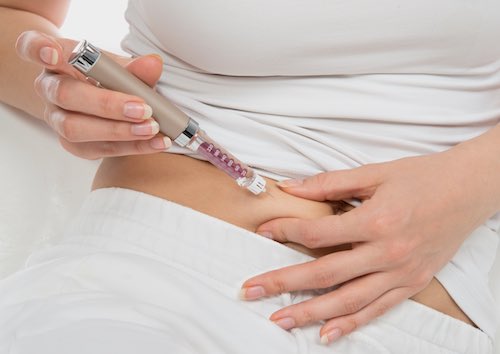If you inject insulin or one of the GLP-1 agonists, the chances are that you are putting yourself at an unnecessary risk of a complication.

The needles you use are probably too long. Only 30 percent of the people who use insulin have adopted the much shorter 4 mm needle that became available in 2010. About half of the people who inject diabetes drugs reuse their needles, particularly those who inject with a pen. Only about 40 percent of needle users rotate their injection sites correctly.
Each of these three problems causes the enlargement of fat cells at the places where you inject. About one-third of people using insulin have this complication, called lipohypertrophy. It leads to A1C levels that average 0.5 percent higher, greater glycemic variability, and unexpected hyperglycemia (high blood glucose episodes).
A large survey
These are the most important findings from one of the largest surveys of people with diabetes — 13,289 insulin-injecting people in 42 countries. Three studies in the September 2016 issue of Mayo Clinic Proceedings report injection practices, complications, and insulin delivery recommendations. Three of the co-authors summarize the “New Insulin Delivery Recommendations” in a short video.
“The key message is that no one needs a longer needle than 4 mm,” the study’s lead author, Anders Frid, MD, and diabetologist at the Skane University Hospital in Malmö, Sweden, said in this video. Using 4 mm needles is associated with less lipohypertrophy than 8 mm needles, the study found. However, 4 mm needles are available only on insulin pens. Currently, the shortest syringe needle is 6 mm.
One of the study’s co-authors, Laurence Hirsch, MD, worldwide vice president of medical affairs for BD Diabetes Care, added that several recent randomized controlled studies now show that the shorter needles are equally effective, are less painful, and have better acceptance by the people who use them than longer ones. Even very obese people do better with 4 mm needles, he said, mentioning a 2015 study.
Lipos are common
“The most common complication that we discovered was lipohypertrophy, which we sometimes refer to as ‘lipos,’” Dr. Hirsch said in the video. “Often it is not visible and has to be sought by careful exam. The risk factors that seem to be the most important are repeated injections to the same site, i.e., poor site rotation and needle reuse.”
The study defined correct site rotation as always injecting at least 1 cm (about 4/10 of an inch) from a previous injection. It also means using a single injection site no more often than once every four weeks.
Up to 30 percent of those who reuse needles do it six or more times, the study says. The more often needles are reused the greater chance of lipos.
Lipos lead to problems
The reason to care about lipos, Dr. Hirsch continued, is that “it leads to glycemic variability and episodes of unexplained hypoglycemia.”
Three of the most important classes of diabetes drugs are injected. All people with Type 1 diabetes must have insulin delivered by injection or a pump to survive, and 29 percent of people with Type 2 diabetes were using insulin in 2012. All of the GLP-1 agonists and Symlin are taken by injection, although people who use Symlin also use insulin too. Just 4 percent of people with diabetes were using one of the GLP-1 drugs in 2012, but that proportion has probably increased a lot since then.
The study found that about one-third of those taking a GLP-1 agonists had lipos. This study recommended that people who use a GLP-1 agonist “should follow the established recommendations for insulin injections,” which include needle length and rotation.
Needle length of GLP-1 drugs
But only two of the five GLP-1 agonists, Byetta and Victoza, are available with 4 mm pens. Bydureon uses 7 mm and 8 mm needles, Tanzeum uses one that is 5 mm, and Trulicity’s is 5 mm long, according to GLP-1 Agonist Medications Chart.
When I used Byetta for about two years starting in February 2006, the 4 mm needles weren’t available yet. I didn’t know anything about site rotation and had never even heard of lipos then.
Injection technique isn’t easy
Unfortunately, even today many people who inject diabetes drugs haven’t been taught how. “Insulin injection has been assumed to be simple and require little training, but that’s not the case,” one of the study’s co-authors, Kenneth Strauss, medical director, BD Europe, stated. They “may have been injecting for years and yet have had little or no training in correct technique.”
When did you learn how to inject one of these diabetes drugs? Even if someone once showed you how to inject, you might want to review your injection technique with your doctor or diabetes educator. Like the short needle that we have been able to use for only a few years, we continue to make progress in dealing with diabetes.
This article is based on an earlier version of my article published by HealthCentral.
Never Miss An Update
Subscribe to my free newsletter “Diabetes Update”
I send out my newsletter on first of every month. It covers new articles and columns that I have written and important developments in diabetes generally that you may have missed.

